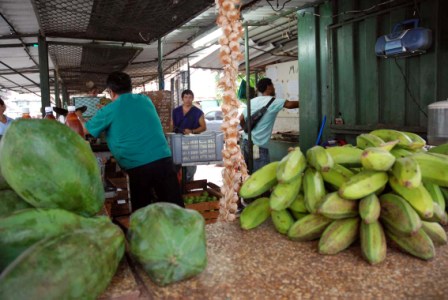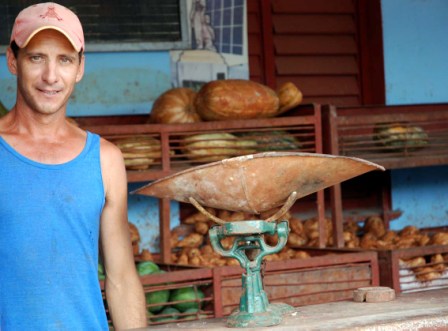Poor Luz Maria
By Irina Echarry

A friend who lives in Old Havana came here more than 20 years ago from her native province, Holguin. Like most people from eastern Cuba, Luz Maria has very defined eating habits that are sometimes unhealthy, given the quantity of fat, salt and seasoning that she adds to her food.
But Luz has the gift of being a first-rate cook. Going to her house is like visiting Havana’s renowned Bodeguita del Medio restaurant; or even better, because you don’t have to get in line…and it’s free. She serves you what she has without thinking twice, even if there’s nothing left for her later on – or the money to buy it. She might have just a helping of beans… but what beans!
She likes to go into her kitchen like a sculptor entering their studio. A pound of peas is transformed into the most exquisite Puré de San Germán.
Luz’s salads have the biggest and reddest tomatoes I’ve ever eaten… and the best avocados.
She prefers to buy her produce at the market on Egido Street. Though it’s more expensive, they have much better quality produce than any other marketplace, be it State-run or private. Egido has the biggest bananas, the sweetest melons, and the freshest cassava – just recently plucked from the earth.
Today I wandered through several markets in Old Havana. Since you can hardly find fresh produce in my neighborhood, I decided to venture over to that part of the city.
The State markets I visited smelled rotten. The odor didn’t allow you to remain for long in those places, let alone buy something. I then recalled my friend’s advice and went immediately to the Egido market, where buyers are welcomed outside by flower vendors, with their lilies, sunflowers and black princes.
However, none of the flower vendors had more than three or four bunches, which gave me an apprehensive feeling. When I entered the vegetable market, there was not much more of a selection.
The first thing that struck me was that half of the stands had no salespeople. Next I noticed the avocados, the kind that Luz usually buys. What were those black stains on their skin? Were they overripe? Yeah, but not really in a natural kind of way.

Most fruits in our country are sold after having been treated in a semi-toxic liquid that “helps them to mature.” It takes away their usual flavor, causes them to go bad more quickly or makes them inedible; this is not to mention the harm this chemical does to your health, which is currently under study according to a few national newspapers. (Meanwhile, no one’s controlling the use of the substance.)
I imagine that Luz won’t eat avocados this week, at least not ones sold at Egido market.
The melons and guavas looked ready for feeding to pigs, though the prices were the same as when they looked like produce for export. It’s better not to talk about the few vegetables on sale; they were from the bonsai family.
There was no rotten smell, only because the building is bigger and better ventilated than the rest of the markets I visited. But the products didn’t differ much.
Imagine – the best vegetable market in Old Havana with produce for pigs.
I wonder how my friend is cooking her treats these days?
Maybe it was only a coincidence? A bad delivery day just when I decided to go there? Maybe next week they’ll be selling better produce?
But where can I buy fruit that’s not adulterated or semi-rotten?
Over the past few months, national newspapers and the television news have featured several reports on the problem of transportation of farm products, showing how sweet potatoes, bananas and guavas rot in warehouses and truck containers before making it to the city.
The words come and go. The produce continues to never make it, and when it does it’s in a state of decomposing.
I think my friend Luz Maria will have to wait for the arrival of the new trucks in the country to once again enter her kitchen with the desire to create art.





